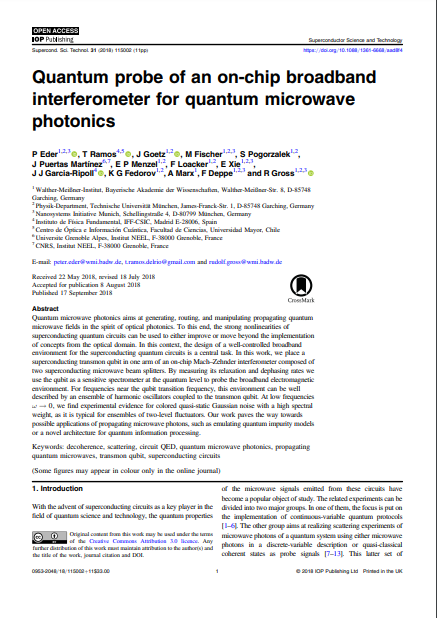Quantum probe of an on-chip broadband interferometer for quantum microwave photonics

Fecha
2018Autor
Ramos, Tomás [Univ Mayor, Fac Ciencias, Ctr Opt & Informac Cuant, Santiago, Chile]
Eder, P.; Goetz, J.; Fischer, M.; Pogorzalek, S.; Martínez, J. Puertas; Menzel, E. P.; Loacker, F.; Xie, E.; García-Ripoll, J. J.; Fedorov, K. G.; Marx, A.; Deppe, F.; Gross, R.
Ubicación geográfica
Notas
HERRAMIENTAS
Acceda a títulos restringidos
¿Cómo descargar?Resumen
Quantum microwave photonics aims at generating, routing, and manipulating propagating quantum microwave fields in the spirit of optical photonics. To this end, the strong nonlinearities of superconducting quantum circuits can be used to either improve or move beyond the implementation of concepts from the optical domain In this context, the design of a well-controlled broadband environment for the superconducting quantum circuits is a central task. In this work, we place a superconducting transmon qubit in one aim of an on-chip Mach-Zehnder interferometer composed of two superconducting microwave beam splitters. By measuring its relaxation and dephasing rates we use the qubit as a sensitive spectrometer at the quantum level to probe the broadband electromagnetic environment. For frequencies near the qubit transition frequency, this environment can be well described by an ensemble of harmonic oscillators coupled to the transmon qubit. At low frequencies omega -> 0, we find experimental evidence for colored quasi-static Gaussian noise with a high spectral weight, as it is typical for ensembles of two-level fluctuators. Our work paves the way towards possible applications of propagating microwave photons, such as emulating quantum impurity models or a novel architecture for quantum information processing.
Coleccion/es a la/s que pertenece:
Si usted es autor(a) de este documento y NO desea que su publicación tenga acceso público en este repositorio, por favor complete el formulario aquí.